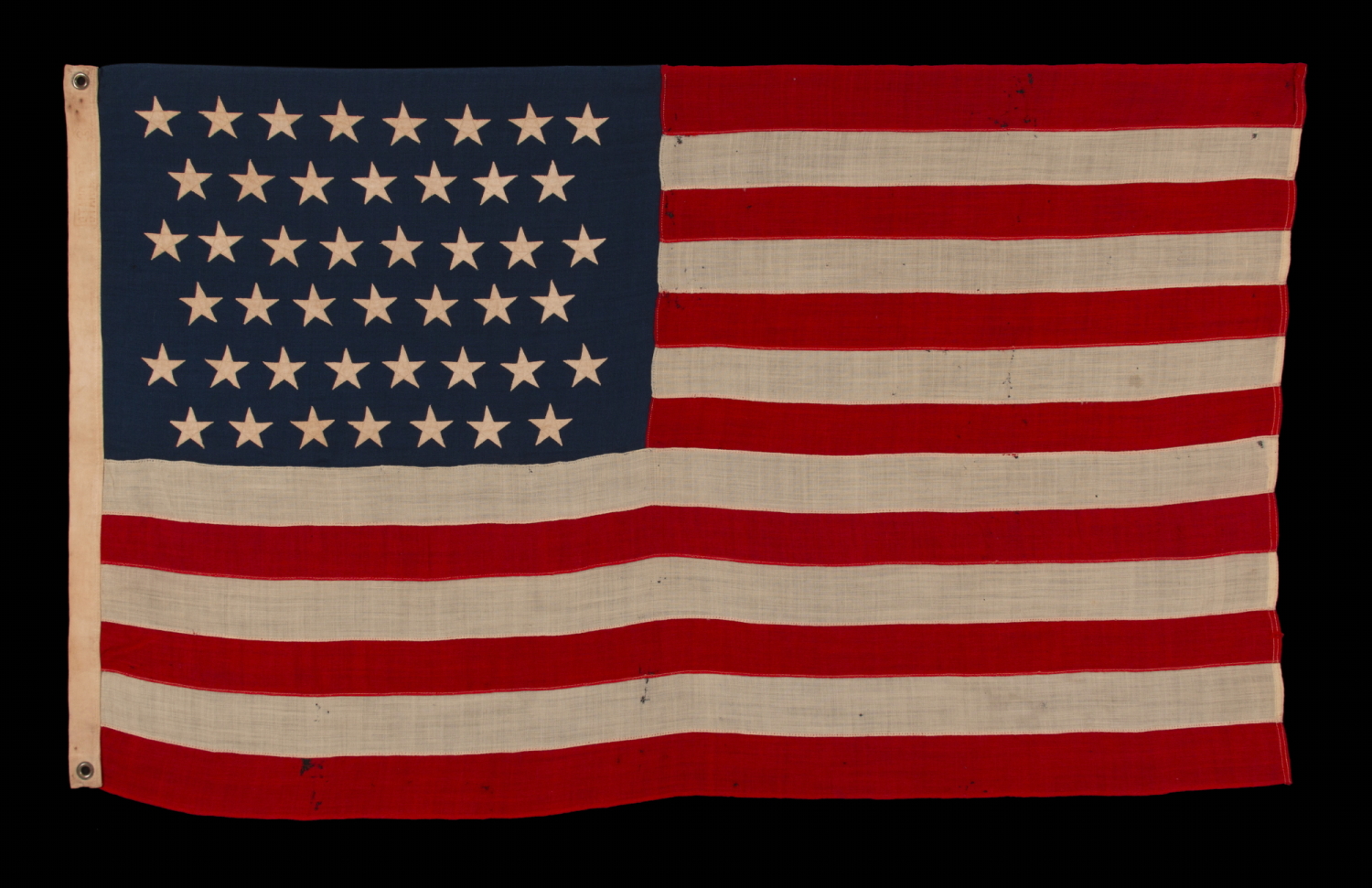


| 45 STAR ANTIQUE AMERICAN FLAG IN A SMALL AND DESIRABLE SCALE AMONG THOSE OF THE PERIOD WITH PIECED AND SEWN CONSTRUCTION, OFFICIAL FROM 1896-1908; MARKED ‘STANDARD”; SPANISH-AMERICAN WAR ERA, REFLECTS THE PERIOD WHEN UTAH WAS THE MOST RECENT STATE TO JOIN THE UNION |
|
| Web ID: | 45j-1018 |
| Available: | In Stock |
| Frame Size (H x L): | Approx. 43.5" x 65.5" |
| Flag Size (H x L): | 35.25" x 57" |
| Description: | |
| 45 star American national flag in a small and extremely desirable scale among those with the white stars individually sewn to the blue canton, and on which the 13 red and white stripes have been assembled from individual lengths of fabric. The stars of the flag are made of plain weave cotton and are arranged in staggered rows of 8-7-8-7-8-7. Although there was no official way to configure the stars on the American flag until 1912, this particular pattern was typical for flags in the 45 star count. The stars have been double-appliquéd (applied to both sides) with a zigzag machine stitch. The canton and striped field are made of wool bunting, that has been pieced and joined by machine with a lineal stitch. There is a twill-woven, machine-sewn binding along the hoist, with two zinc-plated, brass grommets. Along this, near the top, on the obverse (front) are two inked stencils, very faded, that read “Standard” and “3 x 5,” the latter to indicate size in feet. Standard is a name brand of the maker and would have designated the grade of wool bunting, the type of binding, and other factors within the flag’s construction. Utah became the 45th state on January 4th, 1896. It had been attempting to gain statehood for many years, but remained a territory primarily due to the fact that the Mormon Church and Utah authorities continued to be openly tolerant of polygamy. In 1890, Mormon Church President Wilford Woodruff published a manifesto that denounced the contract of “any marriages forbidden by the law of the land,” which paved the way to Utah’s 1896 acceptance. Following the Third Flag Act, accepted by Congress in 1818, stars were to be officially added on Independence Day for any states that had been added over the previous “flag year.” The 45th star was thus officially added on July 4th, 1896, and although 45 remained the official count until July 3rd, 1908, 45 star flags would have generally fallen from production in 1907, when Oklahoma joined the Union as the 46th state. Flag-makers both public and private cared little for official star counts, instead producing what made sense from a practical standpoint, sometimes even adding stars bore the respective states were added, in hopeful anticipation. While the size of the flag may seem large to the casual observer, unfamiliar with those of the 19th century, it is important to understand that most examples with pieced-and-sewn construction, made prior to 1890, were typically 8 feet long or even larger on the fly. A 6-footer was considered small. Although a change in the size of American flags was beginning to take place during the last decade of the 19th century, during which time flag-makers began to produce 3 and 4-footers in quantity for the first time, these typically displayed 13 stars, instead of the full star count, to reflect the 13 original colonies. Sewn flags in the full star count were almost never made in those two sizes, until well into the 48 star period (1912-1959), and though 5-footers, such as this example, appear a bit more frequently during the 45 star era, surviving examples are scarce. Because larger flags in this count are far more common, and at the same time are far more difficult to properly conservation mount and display in a modern, indoor setting, both collectors and one-time buyers alike tend to prefer smaller flags, such as this one. Presidents who served during this period were Democrat Grover Cleveland, in his second, non-consecutive term, the two terms of Republican William McKinley, the second of which was cut short by his assassination (shot 09/06/1901, passed 09/14/1901), and the two terms of Theodore Roosevelt, the first of these attained by ascension. Mounting: Conservation mounting and framing are included. Condition: There are minor to modest areas of loss in the striped field, the most significant of which occur in the first and last stripes, and immediately adjacent to the canton. There is some age toning of the white cotton fabrics and there are tiny rust stains along the hoist. The stenciled markings have significantly faded. Many of my clients prefer early flags to show their age and history of use. |
|
| Video: | |
| Collector Level: | Beginners and Holiday Gift Giving |
| Flag Type: | Sewn flag |
| Star Count: | 45 |
| Earliest Date of Origin: | 1896 |
| Latest Date of Origin: | 1907 |
| State/Affiliation: | Utah |
| War Association: | 1898 Spanish American War |
| Price: | Please call (717) 676-0545 or (717) 502-1281 |
| E-mail: | info@jeffbridgman.com |
 |
|